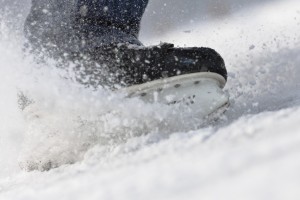
Behind the Scenes with USA Hockey and an Athletic Trainer
1 CommentToday’s blog post is written by guest blogger, Steven Bagus, ATC, NASM-PES. Steven is currently the Assistant Athletic Trainer with the Chicago Fire and also had the opportunity to travel with USA Hockey in November 2013.
Building a team is the first step for any successful Olympic team. While the coaches spend months selecting the perfect combination of players to fill key positions, Athletic Trainers are prepping, packing, and reviewing medical files. The real work begins with building chemistry between the players and medical staff. While each team may have a few players who play on the same team during the regular season, most of the athletes, coaching staff, and support staff are all learning how to work together for one goal – Gold. You may be meeting the players for the first time and building trust is the first step as an Athletic Trainer. The players must have confidence that you are the best in your field as they are the best in theirs.
 The schedule is hectic between practice, weight room, therapy sessions, and the ultimate test – Gameday. A typical day may consist of two practice sessions, morning and afternoon. As the Athletic Trainer, a great deal of prep work is required on these days. First, you must make sure that once the team arrives nothing has been overlooked. For example, the athletic training room must be prepared with tape and modalities ready and functioning. Examples of some modalities that may be used include electrical stimulation, ice, manual therapy, compression, massage, and heat. Second, the locker room must be set with equipment, jerseys, socks, tape, and sticks. Lastly, the benches must be ready with water bottles, towels, and pucks. The support staff, Athletic Trainer, and Equipment Managers will always be the first to the rink. Once the team arrives, getting the players ready to take the ice is the goal. This may include warming up, stretching, taping, treating any previous injuries, evaluating new injuries, and deciding who is safe and ready to take the ice. Post-practice involves evaluating any injuries that may have occurred, taking care of lingering injuries, and recovery. Recovery is key in the Olympic setting because off days, a precious commodity being used primarily to eat, recover, and prepare for the next day, come few and far between so anything that can be done to decrease pain, soreness, or tightness is key.
The schedule is hectic between practice, weight room, therapy sessions, and the ultimate test – Gameday. A typical day may consist of two practice sessions, morning and afternoon. As the Athletic Trainer, a great deal of prep work is required on these days. First, you must make sure that once the team arrives nothing has been overlooked. For example, the athletic training room must be prepared with tape and modalities ready and functioning. Examples of some modalities that may be used include electrical stimulation, ice, manual therapy, compression, massage, and heat. Second, the locker room must be set with equipment, jerseys, socks, tape, and sticks. Lastly, the benches must be ready with water bottles, towels, and pucks. The support staff, Athletic Trainer, and Equipment Managers will always be the first to the rink. Once the team arrives, getting the players ready to take the ice is the goal. This may include warming up, stretching, taping, treating any previous injuries, evaluating new injuries, and deciding who is safe and ready to take the ice. Post-practice involves evaluating any injuries that may have occurred, taking care of lingering injuries, and recovery. Recovery is key in the Olympic setting because off days, a precious commodity being used primarily to eat, recover, and prepare for the next day, come few and far between so anything that can be done to decrease pain, soreness, or tightness is key.
Gameday is another animal. Nothing can be overlooked. Anything that the player needs or wants must be ready on request. Each player will have their own unique gameday rituals to prepare themselves for a top performance. It may seem like that most of the work is done once the athletes take the ice, however, an Athletic Trainer needs to stay on his/her toes throughout the game ready for any injury whether it be severe or minor. You may need to put a bandage on a small cut but you must also be prepared to spine board a neck injury or evaluate a concussion. During games, your evaluation of an injury must be thorough to ensure player safety but it also must be quick to get the player back on the ice as quickly as possible. Watching the game from the bench may be the best seat in the house but Athletic Trainers must be constantly scanning the ice for an athlete who went down as well as surveying the players that come back to the bench.
Overall, when traveling with a team, an Athletic Trainer’s job is never ending. Preparing for practice and games, treating injuries post activity, and being available to the players throughout the night is all part of the job. An Athletic Trainers job may be arduous at times but it all pays off seeing your team be successful and putting a medal around your neck!


1 Comment
Jane BAGUS
What an incredible amount of work to build a successful team!